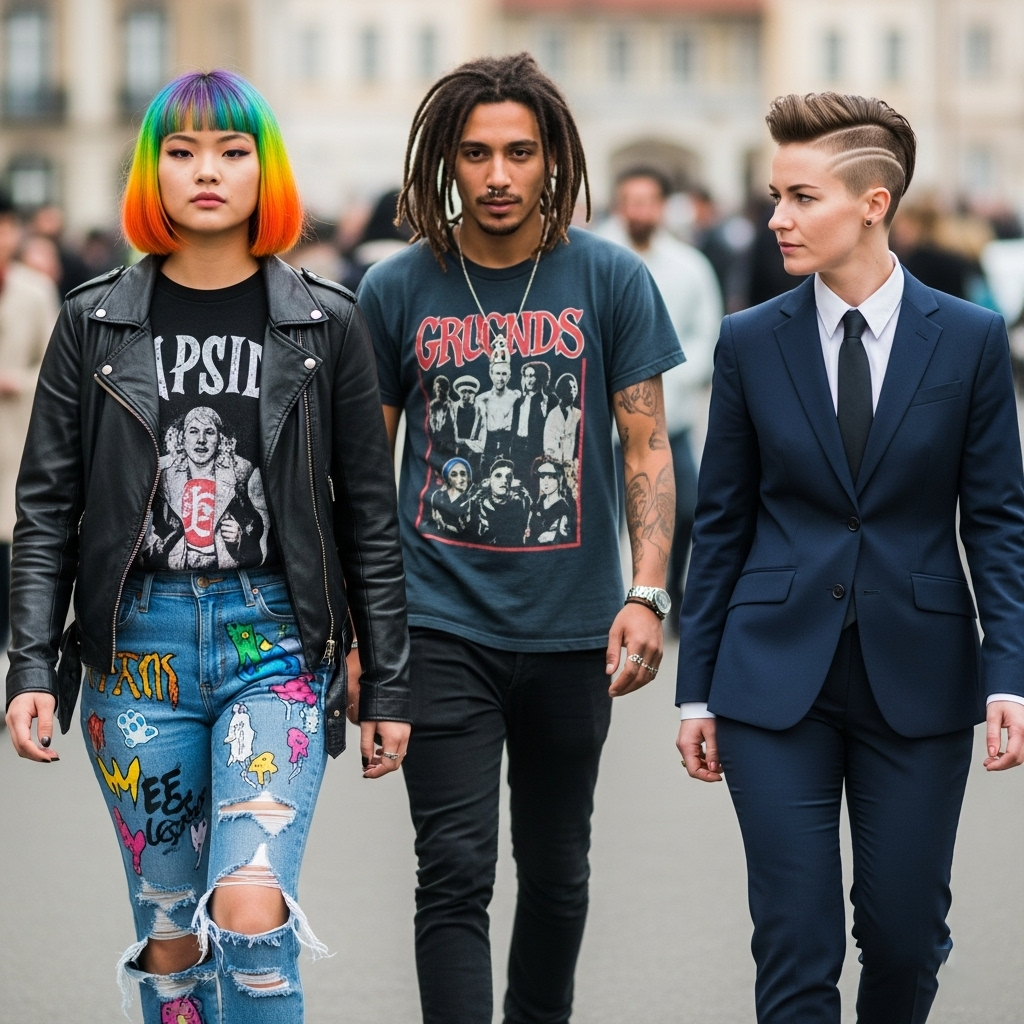
Fashion and Subcultures: How Style Defines Identity
Fashion is more than just clothing; it’s a powerful form of self-expression, a visual language that communicates identity, values, and belonging. Throughout history, subcultures have used style as a potent tool to define themselves, to create a sense of community, and to challenge mainstream norms. From the rebellious spirit of punk to the elegant sophistication of goth and the vibrant energy of hip-hop, subcultural styles offer a fascinating glimpse into the diverse ways in which fashion can articulate identity and spark social change.
Punk: Rebellion and Anti-Fashion
Emerging in the mid-1970s in the UK and the US, punk was a reaction against mainstream consumerism and a celebration of anti-establishment attitudes. Punk fashion was deliberately shocking and confrontational, a visual manifestation of its rebellious spirit.
- DIY Aesthetics: Ripped clothing, safety pins, and DIY patches were hallmarks of punk style, reflecting a rejection of mass-produced fashion and a celebration of individuality.
- Rebellious Symbols: Leather jackets, studded belts, and Doc Martens boots became iconic symbols of punk rebellion, representing toughness and defiance.
- Anti-Fashion: Punk deliberately challenged traditional notions of beauty and style, embracing unconventional silhouettes, provocative graphics, and a raw, unpolished aesthetic.
Goth: Elegance and Darkness
Goth subculture, emerging from the post-punk scene in the late 1970s and early 1980s, embraced a darker, more romantic aesthetic, drawing inspiration from Victorian mourning attire, literature, and art.
- Dark and Dramatic: Black clothing, lace, velvet, and corsets were staples of goth style, creating a sense of dramatic elegance and mystery.
- Symbolic Accessories: Silver jewelry, particularly crosses and other gothic symbols, played a significant role in defining the goth aesthetic.
- Androgyny: Goth fashion often blurred traditional gender lines, with men and women embracing similar styles and silhouettes.
Hip-Hop: Style as Self-Expression
Emerging from the Bronx in the 1970s, hip-hop culture revolutionized music, art, and fashion. Hip-hop style was about comfort, self-expression, and a celebration of urban identity.
- Oversized Silhouettes: Baggy jeans, oversized t-shirts, and hoodies became iconic hip-hop staples, reflecting a sense of comfort and street credibility.
- Sneakers as Status Symbols: Sneakers, particularly limited-edition and designer styles, became highly coveted status symbols within the hip-hop community.
- Bold Accessories: Gold chains, baseball caps, and bucket hats were essential accessories, adding a touch of swagger and personality to hip-hop style.
Other Influential Subcultures
- Mod: Emerging in the 1960s, the Mod subculture in the UK embraced sharp, tailored clothing, Italian scooters, and a sophisticated, modern aesthetic.
- Rocker/Biker: Leather jackets, denim, and motorcycle boots defined the rocker/biker subculture, representing a rebellious spirit and a love of speed and freedom.
- Bohemian/Hippie: Flowing fabrics, natural materials, and ethnic-inspired prints characterized the bohemian/hippie subculture, reflecting a love of nature, peace, and individuality.
- Lolita: Originating in Japan, the Lolita subculture embraces a Victorian-inspired aesthetic with elaborate dresses, petticoats, and a focus on cuteness and innocence.
- Kawaii: Also originating in Japan, the kawaii subculture celebrates all things cute, with bright colors, playful accessories, and a childlike aesthetic.
- Rave: Electronic music and dance culture gave rise to the rave subculture, with its emphasis on neon colors, futuristic silhouettes, and practical, comfortable clothing for dancing.
The Enduring Legacy of Subcultural Styles
Subcultural styles have had a profound impact on mainstream fashion, influencing everything from runway trends to street style. Designers often draw inspiration from subcultural aesthetics, reinterpreting and adapting them for a wider audience. Subcultures continue to evolve and innovate, creating new and exciting styles that challenge conventions and push the boundaries of fashion.
Fashion as a Tool for Social Change
Subcultural styles are not just about aesthetics; they are often powerful statements of social and political beliefs. They can be used to challenge norms, express dissent, and advocate for change. Fashion can be a powerful tool for marginalized communities to assert their identity, reclaim their narrative, and fight for equality.
The Future of Subcultural Styles
As society continues to evolve, so too will subcultures and their unique styles. The internet and social media have created new platforms for subcultures to connect, share their aesthetics, and influence global trends. The future of subcultural style is likely to be even more diverse, experimental, and boundary-pushing, reflecting the ever-changing landscape of human identity and expression.


Add comment